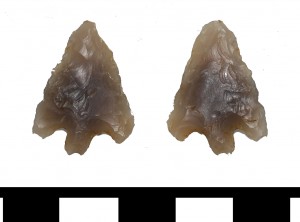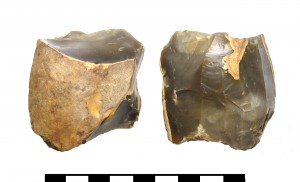Flint is a very difficult thing to spot when out about in a field – well it is for me anyway. Oh don’t get me wrong, I can pick up bits of flint until the cows some home, but never ever have I managed to spot a worked piece! However, there are people out there with a sharp eye who manage to spot these fantastically crafted objects.
Quite often the flint I am given to to record onto the database are tools such as ESS-98FF03 a Mesolithic adze, ESS-388BD4 a Neolithic polished axe or this exquisite barbed and tanged arrow head ESS-7B4111.

Bronze Age arrowhead
As interesting and beautiful as completed tools are, the main thing I have been working on this week is a load of old rubbish. In fact I have been recording and identifying Mesolithic rubbish from an assemblage found in the Colchester District, to be a little more precise. Although a few tools were brought in with the assemblage, the majority of the finds have been waste flakes (discarded fragments of knapped flint) and cores that have had flakes and blades removed from the surface; see ESS-CFD107, ESS-CFCDD4 and ESS-CFF7C4 for a few examples.

Bladelet core
These discarded waste flakes and cores were not needed or adapted into tools by prehistoric man, and they may not be as aesthetically pleasing to the modern eye as the completed tools, but they are vitally important to archaeologists. They help us to identify areas where knapping took place, which means we are identifying where the tools were actually being made. This can be really interesting, as flint can be a rare commodity in parts of the country, and tool production does not always take place at the source of the flint. All the ‘rubbish’ can actually be more informative than a discarded tool. So recording flint assemblages, or even only one or two pieces can help us to understand peoples interactions, use of the landscape and the materials available to them.
Flint is a wonderful thing, but it can also be tricky and misleading!! Not all of the flint brought into me for recording over the years has been worked by humans. The shaping of it can be entirely natural. A lot of smaller flint nodules can fit wonderfully well in the hand without having been worked at all. Even fractured flint nodules may be the result of the natural environment, such as frost fractured ‘pot lids’.
Given the right conditions (such as freezing and thawing) flint can break naturally in quite a regular looking way. This is because the structure of flint is like a large lattice or grid – so natural breaks will quite often be relatively straight or angular, which people can mistake as being man made due to their regularity.
It is this natural property of flint that made it such a great material to turn into tools. The lattice structure makes it relatively predictable as to where the breaks will form when pressure is applied, hence in prehistory we see a recognisable range of tools of similar design time and time again. These angular breaks are also exceptionally sharp – and some of the tools brought in for recording are still sharp today, thousands of years after they were made.
It can be tricky to spot some of the differences between natural fractures, damage caused by modern farming machinery and deliberate man made removals. If you bring a piece in for recording and it turns out to be natural breaks, rather than worked, you are still holding a piece of really old natural history in your hands that was formed millions of years ago!
Why don’t you check ESS-851F72, a fantastic example of natural history meeting human history – an incomplete Mezolithic Adze made from a flint nodule which is covered in a fossilised sponge.